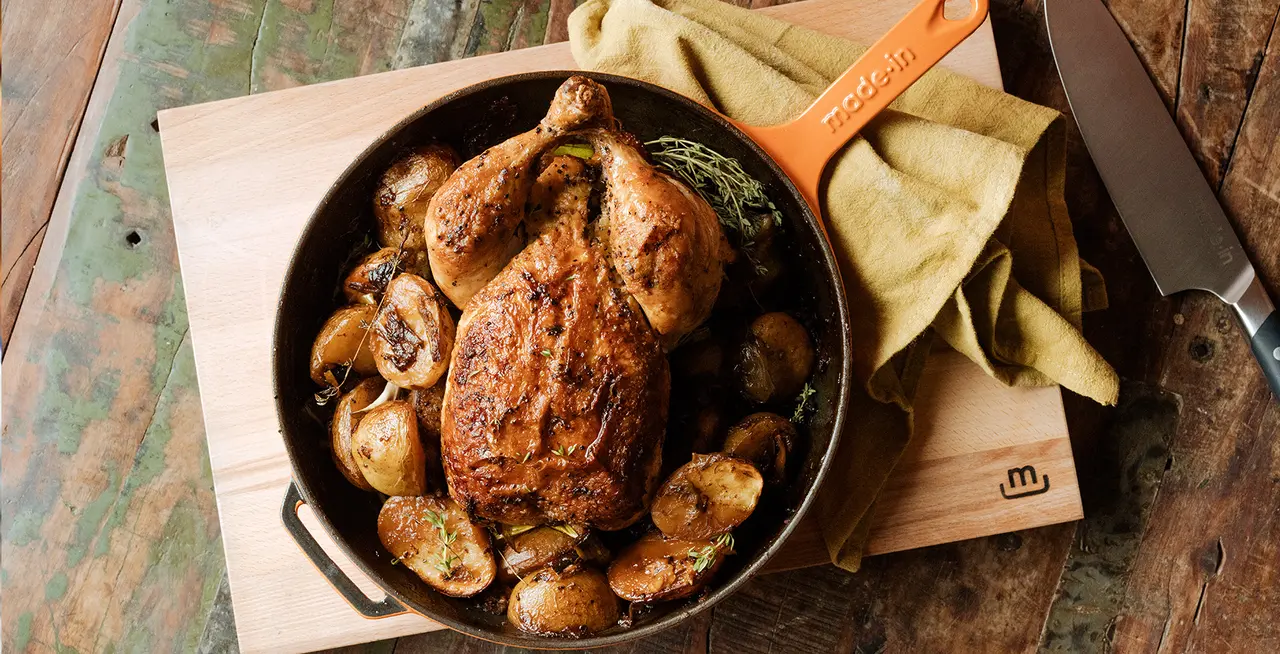If you’ve ever had to suffer through a dry, chewy chicken breast or burnt thigh, you know that a good pan can make all the difference when cooking this staple protein. Since the margin of error is slightly smaller with chicken than with steak—which is fine to eat even if it’s a bit rare—you want a pan with excellent heat distribution, whether you’re roasting, frying, or sautéing.
That said, just like there’s no single best recipe for chicken, there’s no single best pan for cooking it (though some are more versatile than others). To help you choose the right pan for cooking tender thighs, crispy cutlets, or succulent coq au vin, we’ve created this comprehensive guide. Read on to learn when to use cast iron vs carbon steel, what silhouette works best for deep frying, and new methods for preparing your favorites.
- Most Versatile: Enameled Cast Iron Skillet
- For Perfect Sears: Stainless Clad Frying Pan
- For Easy Cleanup: Non Stick Frying Pan
- For Crispy Fried Chicken: Dutch Oven
- For Simple Stove-to-Oven Braises: Stainless Clad Rondeau
- For Outdoor Cooking: Carbon Steel Grill Frying Pan
- For Tender Baked Chicken: Porcelain Baking Dish
- Ready to Cook?
Most Versatile: Enameled Cast Iron Skillet
Our Enameled Cast Iron Skillet might be the closest thing you can find to an all-purpose pan—especially when it comes to cooking chicken. From pan roasting to shallow frying to sautéing, you can pretty much do it all in this incredibly versatile piece of cookware.
If you don’t have a roasting pan—or you don’t feel like hauling yours out for a small, 3-4 pound bird—a cast iron skillet can deliver similar results. Pro tip: you can also use your skillet to bake an entire chicken pot pie.
For Perfect Sears: Stainless Clad Frying Pan
For flawlessly seared chicken breasts or thighs, our vote goes to our Stainless Clad Frying Pan. Fully cladded from 5 layers of metal for optimal heat conductivity, our Stainless Clad allows for precise heat control—meaning you can sustain the exact level of heat needed for deeply browned, crispy skin.
Plus, since stainless steel is non-reactive, you can use acidic ingredients like wine, citrus, tomato paste, or capers to create a velvety pan sauce when you’re done (maybe not all at once, though).
For Easy Cleanup: Non Stick Frying Pan
If your main objective is easy cleanup, then non stick is a no-brainer. While you might not get as deep of a sear as you would in a carbon steel or cast iron skillet, a quality non stick frying pan (like ours) should feature a core material made of stainless steel or another heat conductor. This means efficient conductivity at lower temperatures, which results in juicy, golden brown cutlets or tender, lightly charred stir fries any night of the week, without needing nearly as much heat.
For Crispy Fried Chicken: Dutch Oven
You can roast a whole chicken just as easily you can deep fry one in your enameled cast iron Dutch oven—in fact, it’s one of the absolute best tools for the job. The incredible heat retention of cast iron combined with its smooth, easy-to-clean enameled surface makes for safe and effective deep frying at home.
And while we love the cast iron skillet for shallow frying things like cutlets, a wide, deep pot like a Dutch oven is an absolute must for deep-frying chicken, donuts, and more. The high sides allow you to add enough oil to fully submerge your food, while minimizing hot oil splatter.
For Simple Stove-to-Oven Braises: Stainless Clad Rondeau
Looking for a single, one-and-done pan for simple braised chicken dishes? Try our Stainless Clad Rondeau, which gives you the excellent searing power of stainless steel cookware but with a bit more depth, so it holds plenty of braising liquid. With two side helper handles, you can carry even the biggest cut to the table with ease.
For Outdoor Cooking: Carbon Steel Grill Frying Pan
If you’re anything like us, you like eating grilled chicken wings way more than you like cleaning and oiling the grates of your outdoor grill. Our Carbon Steel Grill Frying Pan offers the perfect solution: made of highly conductive carbon steel and perforated for maximal food-to-flame contact, this pan is the perfect surface for safe, convenient grill cooking without sacrificing any ingredients to the grill grates.
Ours is made to tolerate temperatures of up to 1200F and weighs significantly less than cast iron counterparts. The Grill Frying Pan is both easy to maneuver and offers the same great heat retention as our other Carbon Steel Cookware.
For Tender Baked Chicken: Porcelain Baking Dish
For chicken dishes that require low and slow cooking, we like to use any size of our Porcelain Baking Dishes. While metal pans might work well for thin, crispy chicken cutlets because of how quickly they heat up, we prefer porcelain for baked chicken—as well as lasagnas, bread puddings, and casseroles—because they heat up more slowly, and distribute that heat evenly throughout the dish. This ensures uniform browning and perfectly tender interiors.
Another major benefit of our porcelain bakeware is that it's naturally non stick and thermal shock-resistant. This means you can transfer your dish to the oven straight from the fridge, and even put it under the broiler and have an easier time scraping up any juices that may have gotten baked on in the oven.
Ready to Cook?
If chicken for dinner is starting to feel a little boring, we strongly suggest switching up your pan. Break out our Stainless Clad Frying Pan if you’re craving crispy thighs, the Carbon Steel Grill Pan for perfectly BBQed chicken wings, or the Non Stick Frying Pan for a low-effort but totally delicious weeknight stir-fry.
The world is your oyster—which just so happens to be our favorite part of a roast chicken.



































